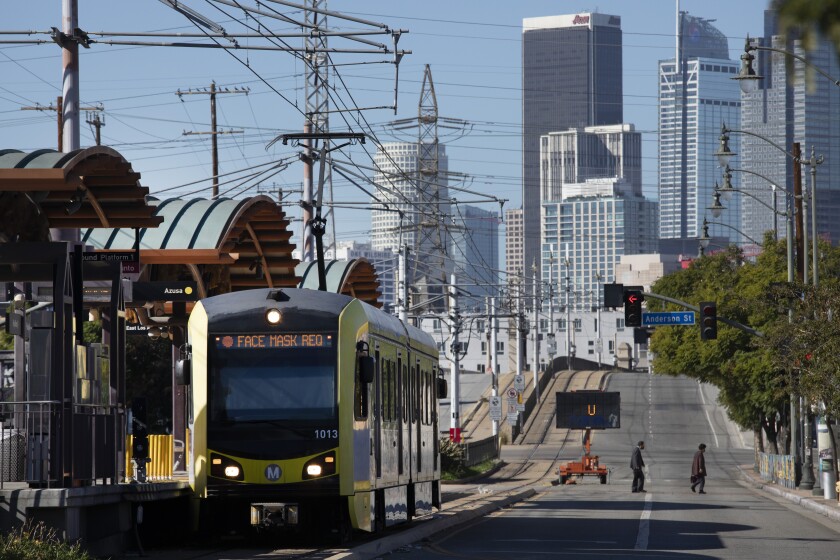Gov. Gavin Newsom needs to shift house development in California clear of rural, wildfire-prone spaces and towards city cores as a part of his $286.4-billion finances plan that targets to align the state’s housing technique with its local weather objectives.
The finances blueprint Newsom detailed this week contains $2 billion over two years in grants and tax credit to incentivize housing construction nearer to town facilities so that you could lower lengthy automobile commutes and stay other people close to their “day-to-day locations.”
“It is a center of attention on shifting clear of the wildland-urban interface,” Newsom mentioned Monday, relating to shifting construction clear of rural spaces outdoor the outer edge of maximum California towns and the place fires mechanically burn. “Transferring clear of investments in housing that don’t center of attention on local weather, well being, integrating downtown, colleges, jobs, parks and eating places.”
The proposal would construct at the $10.3 billion state officers allocated ultimate yr to strengthen mixed- and low-income housing in California, however marks an evolution within the governor’s strategy to fixing the state’s multimillion-unit scarcity. Although earlier budgets have allotted vital cash to reasonably priced construction, Newsom’s new plan would particularly steer investment towards housing initiatives in city spaces with current sources, loosely outlined as “downtowns” and “primary streets.”

Resident Kevin Aquino pictures the skyline from the rooftop deck of a downtown L.A. condominium development on Oct. 28, 2021.
(Gary Coronado / Los Angeles Instances)
The management’s objective is to push native governments to plot for and allow tens of millions of recent devices in spaces already ripe for construction and use to their merit present regulations that accelerate the method. That means, state officers imagine, towns can meet regional housing objectives and keep away from so-called city sprawl, which might push other people into spaces at excessive possibility for fireplace and put extra polluting vehicles at the street throughout rush hour.
Jason Elliott, Newsom’s best housing marketing consultant, mentioned the governor’s finances interlaces housing, cost-of-living and local weather insurance policies to concurrently cope with California’s best problems.
“The entire executive, in the case of housing, wildfire, surroundings, is pointed towards development extra downtown-oriented housing,” Elliott mentioned. “It’s higher for fairness, it’s higher for inclusion, it’s higher for the surroundings.”
The $2 billion contains $500 million in grants for nonprofit and for-profit builders or native governments to build extra devices on current, however underused, city land on the subject of town facilities and transportation, and $300 million for sustainable initiatives in spaces pleasant to strolling and cycling and close to public transit. Newsom additionally needs to direct loads of tens of millions of greenbacks towards the use of extra state-owned land for reasonably priced construction and easing the associated fee burden of changing current buildings into residential areas in downtown spaces.
The plan would additionally supply $500 million in low-income housing tax credit for builders and $500 million to keep and build up the state’s reasonably priced and mixed-income housing inventory and rehabilitate cellular house parks.

A Gold Line educate stops at a station on 1st Side road in Los Angeles
(Myung J. Chun / Los Angeles Instances)
Ray Pearl, govt director of the California Housing Consortium, mentioned the investments lend a hand set expectancies for reasonably priced construction and make it transparent that Newsom needs to look extra parking loads, dilapidated constructions and surplus land repurposed to deal with households.
“When the governor of your state says that is your precedence, other people pay attention,” Pearl mentioned.
Daniel Sider, leader of workforce for the San Francisco Making plans Division, additionally applauded Newsom’s announcement.
San Francisco’s downtown, even though its limitations aren’t officially outlined, stretches from the Monetary District to SoMa and contains the Tenderloin, Nob Hill and Chinatown. Those dense neighborhoods are house to an estimated 13.5% of the town’s just about 875,000 citizens, Sider mentioned, bringing up 2019 numbers. He mentioned the town has enough room so as to add tens of hundreds of devices in those spaces and may just use the investment to assist in making it occur.
“The speculation is unbelievable,” Sider mentioned. “Huge brush, that is spot on. That is [like] San Francisco, this stage of infill construction.”
Newsom’s imaginative and prescient additionally enhances town making plans objectives in Los Angeles, together with for Central Town and Central Town North, which surround 70,927 of the town’s 2019 inhabitants of greater than 3.9 million. The town’s Downtown Neighborhood Plan may just upload as much as 175,000 citizens and 100,000 housing devices by means of 2040 so that you could revitalize Los Angeles’ “business, leisure, cultural, and civic middle.”
Different L.A. neighborhoods also are anticipated to develop, even though at a slower price than what the making plans company has in thoughts for downtown. Some town regulations wouldn’t permit as an example, creating high-rise flats with loads of recent devices. Newsom’s plan emphasizes duty for native governments all the way through California to plot for better density, however that would additionally come with duplexes and fourplexes.
Newsom’s proposal displays the demanding situations forward in fixing California’s housing affordability disaster.
The median price ticket for an current single-family house in November used to be $782,480, in step with state Division of Finance information, a dip under numbers that surged previous the $800,000 mark previous in 2021. California could also be house to probably the most most costly condominium markets within the nation. A one-bedroom condominium prices a median of $2,200 in Los Angeles, in step with the true property web site Zumper, and jumps to $2,850 in San Francisco.
90 % of respondents in a March survey by means of the nonpartisan Public Coverage Institute of California mentioned housing affordability used to be an issue of their area, and 33% mentioned they might severely believe leaving the state as a result of the prices.
The ripple impact is clear all the way through the state, as extra low- and middle-income Californians flee their costlier communities on the lookout for inexpensive prices of dwelling, a development that deepens inequities and exacerbates lengthy commutes.
“I’ve many, many of us in my network who paintings in my network and do four-hour journeys house,” mentioned Assemblywoman Buffy Wicks, an Oakland Democrat and chair of the Meeting Housing and Neighborhood Building Committee. “They’re spending 3 or 4 hours at the street each and every unmarried day as a result of they may be able to’t find the money for to are living within the communities they paintings.”
However even though Newsom’s proposed investments may just “lend a hand get other people out of vehicles,” mentioned Mary Creasman, leader govt of California Environmental Electorate, extra incentives are had to decarbonize the housing trade and be sure that any new devices don’t irritate the local weather disaster. Creasman mentioned the Newsom management must do extra to broaden inexperienced areas reminiscent of parks, which build up high quality of dwelling and play a task in local weather mitigation inside of towns.
“What we’re development must be carbon-free, and the way we’re development must be with community-greening infrastructure,” Creasman mentioned.
Assemblyman Vince Fong (R-Bakersfield) additionally advised warning, announcing that he needs to know the way rural counties will obtain investment in comparison with city counties. He famous that extra is had to cope with the core of the housing affordability disaster, together with regulatory prices, exertions necessities and the environmental overview procedure for brand spanking new initiatives.
“On the finish of the day, as charge of housing continues to move up, the bucks which can be being put into housing aren’t going a long way sufficient,” Fong mentioned. “We need to cope with the basics. We need to get again to the fundamentals on the subject of housing.”
